Product
Firmness
Score
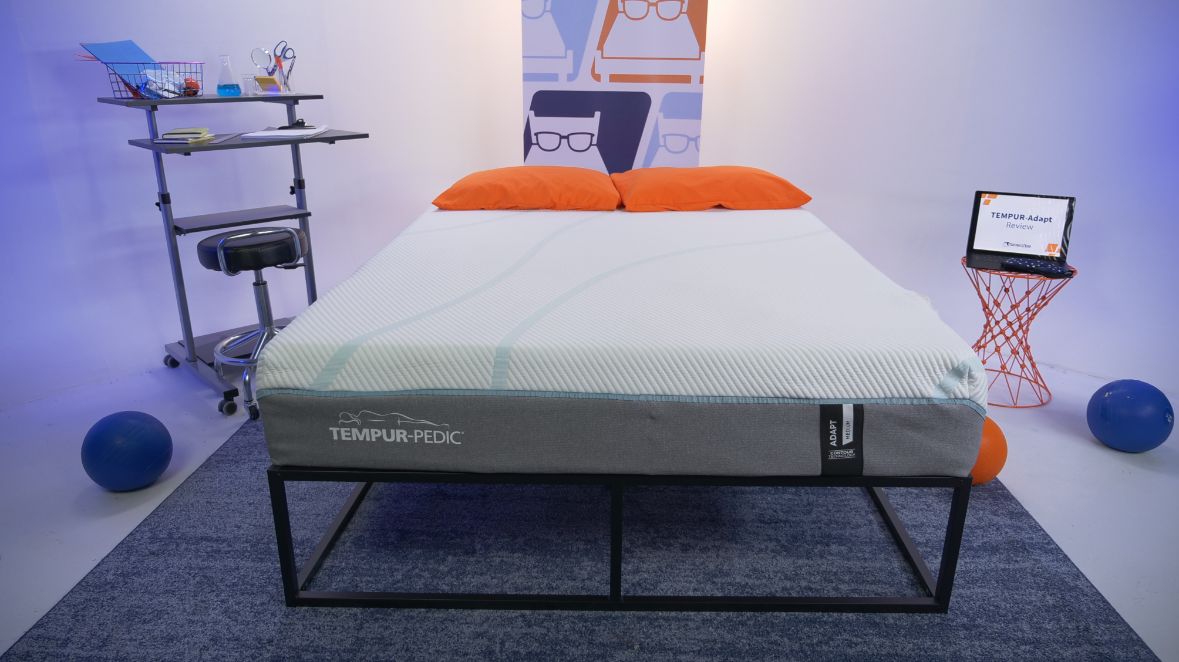
Disclosure: By clicking on the product links in this article, Mattress Nerd may receive a commission fee at no cost to you, the reader. Read full disclosure statement.
Intro/ summary: Below, we explore the differences and similarities, construction, performance, and key policies (for instance, the shipping, warranty, and sleep trial) of the flagship Nectar mattress and the TEMPUR-Adapt by Tempur-Pedic. Keep reading to learn which might be right for you.
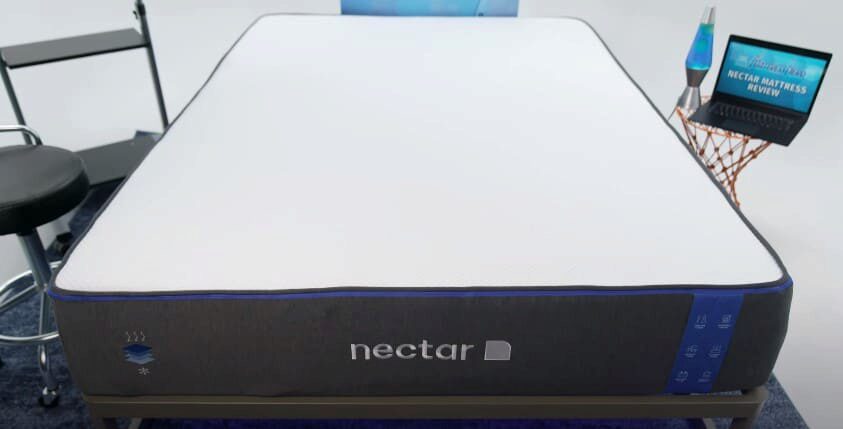

The flagship Nectar is best for value shoppers looking for the signature hug of memory foam on a budget while The original Nectar mattress boasts a three-layer memory foam bed with a medium-firm firmness setting and a traditional memory foam feel.
| Nectar is best for… | Tempurpedic is best for… |
| Value shoppers | Average-weight sleepers |
| Most side and back sleepers | Back sleepers |
| Couples | Hot sleepers |
Both the Nectar and the TEMPUR-Adapt fall into the mid-range of the firmness scale, making them suitable for most average-weight sleepers.
Both the Nectar and the TEMPUR-Adapt fall into the mid-range of the firmness scale, making them suitable for most average-weight sleepers. The Nectar works especially well for back and side sleepers, and the TEMPUR-Adapt’s slightly firmer feel works very well for back sleepers. Stomach sleepers are likely to feel some unhealthy torso and hip sinkage on both mattresses.
Nectar added stabilizing measures in its construction to balance the hugging feel of memory foam without feeling stuck in the mattress. The Tempur-Adapt mattress feels solid and supportive, even around the edges, giving it a durable feel too.
Some of the softer upper layers of the Nectar may cause heavier side sleepers and heavier stomach sleepers to sink into the mattress. If you are a plus-size sleeper, see the best mattress for heavy sleepers. Tempurpedic works great for average stomach sleepers of all weights who need extra hip support, along with heavyweight sleepers too.
Nectar Performance By Body Type & Sleeping Position:
| Body Type: | BACK SLEEPERS | STOMACH SLEEPERS | SIDE SLEEPERS |
| Lightweight (< 130 lbs): | 4 | 3 | 3 |
| Average-weight (130–230 lbs): | 4 | 2 | 5 |
| Heavyweight (> 230 lbs): | 2 | 2 | 3 |
Tempurpedic Performance By Body Type & Sleeping Position:
| Body Type: | BACK SLEEPERS | STOMACH SLEEPERS | SIDE SLEEPERS |
| Lightweight (< 130 lbs): | 4 | 4 | 3 |
| Average-weight (130–230 lbs): | 4 | 3 | 4 |
| Heavyweight (> 230 lbs): | 3 | 2 | 3 |
Average-weight back sleepers should find their spines stay aligned on top of the Nectar, the same with side and combination sleepers who should sink into the contouring layers designed to keep the spine aligned. Stomach sleepers who want to avoid pressure build-up in their hips should consider other mattresses.
Tempurpedic is best for back sleepers of all weights as it has the contouring relief of memory foam and the support of a firmer mattress. Also ideal for stomach and side sleepers to relieve pressure. Combination sleepers may need to stray away as it feels more sinking than responsive.
For the Nectar heavyweight back sleepers, it could feel like the mattress sinks more than they’d like, together with stomach and combination sleepers who may feel sinkage on the hips. However, side sleepers should sink into the contouring layers designed to keep the spine aligned.
Tempurpedic is best for back and side sleepers of all weights as it has the contouring relief of memory foam and the support of a firmer mattress. Stomach and combination sleepers may find it too soft and unresponsive and may need more firmness.
Lightweight back sleepers should find their spines stay aligned on top of the Nectar. Offering plenty of support for stomach and combination sleepers with its memory foam, side sleepers may want to opt for a softer mattress.
Tempurpedic is best for back and side sleepers of all weights as it has the contouring relief of memory foam and the support of a firmer mattress. Stomach sleepers may find its support firm enough but combination sleepers will have a hard time as it is not as responsive to movement.
Introducing the mattress construction and builds to further know about the adaptability and the science behind the Nectar and Tempurpedic.
| Nectar Mattress Materials | Nectar Mattress Materials |
| Knit blend | Dual-Layer SmartClimate cover |
| 2” Gel memory foam | TEMPUR-ES memory foam |
| 4” Soft conventional foam | TEMPUR support layer |
| 6” Polyfoam |
The Nectar cover is woven with a fabric blend, which is breathable and helps keep the mattress cool compared to other all-foam mattresses. The TEMPUR-Adapt is encased in a cool-to-touch cover that’s described as “premium knit technology for superior cool-to-touch feel,” but the exact composition of the cover is not disclosed.
In the comfort layer of the Nectar is 3″ of gel memory foam. The gel infusion is intended to prevent some of the heat-trapping properties of memory foam. The top layer of the Adapt is a TEMPUR-ES comfort layer. TEMPUR-ES memory foam offers a softer feel that Tempur-Pedic says works well to both support and relax the sleeper.
The base layer of the Nectar is a 7” layer of high-density foam, which provides structure, durability, and lift to encourage spinal alignment. The support core of the all-foam version is a high-density foam, or the Original TEMPUR Support Layer.
| Size | Nectar Prices | Tempurpedic Prices |
| Twin | $699.00 | $1999.00 |
| Twin XL | $899.00 | $1999.00 |
| Full | $949.00 | $2349.00 |
| Queen | $1099.00 | $2499.00 |
| King | $1399.00 | $3199.00 |
| California King | $1399.00 | $3199.00 |
For exclusive discounts on both beds see our Nectar mattress coupons and Tempurpedic mattress coupons.
The Nectar is a value memory foam mattress that excels at providing pressure relief and minimizing motion transfer. The medium-firm feel is ideal for cradling pressure points. Plus, it comes with a yearlong trial period and a Lifetime warranty.
Nerd Score
3.7/5
With decades of expertise making memory foam beds, it’s hard to not love TEMPUR-Pedic. The TEMPUR-Adapt is the baseline memory foam mattress model they offer and is sure to deliver a return on your investment.
Nerd Score
3.5/5
Both beds incorporate some cooling features, but we don’t think you will sleep actively cool on either mattress. If you select the hybrid version of the TEMPUR-Adapt, you’re likely to experience a much cooler night’s sleep thanks to the ample airflow through the coil layer. Check out the best cooling mattresses for hot sleepers for more top picks.
If you share a bed with a partner, you may be easily disturbed by their movements at night. The Nectar and the all-foam version of the TEMPUR-Adapt offer very low motion transfer and make virtually no noise, making both great choices for couples and co-sleepers who toss and turn at night. For other motion-isolating mattresses, see the best mattresses for couples.
Edge support, or the resistance to sinkage around the perimeter of a mattress, is key for people who like to sit on the edges of the bed. Edge support is also great for some elderly individuals and for couples who want to use the full surface area of a mattress. It can also be a key indicator of a mattress’ durability. The Nectar and the all-foam TEMPUR-Adapt perform as expected for memory foam beds, sinking significantly close to the edges. The TEMPUR-Adapt hybrid version offers better performance in this category.
Both the Nectar and the TEMPUR-Adapt mattress are known for their ability to cradle a sleeper closely, allowing just enough sinkage for the body to relax without a sagging sensation in the spine. If we had to choose, we’d say the TEMPUR-Adapt offers better pressure relief than the Nectar from the brand’s signature, proprietary TEMPUR-ES foam. The Nectar mattress, however, offers superb pressure relief for the price. For other pressure-relieving mattresses, see the best mattresses for side sleepers.
A mattress that keeps your spine in its natural “S” curve throughout the night is essential to sleep health. If you’re a lightweight sleeper, we think you’ll feel better on the slightly softer Nectar, which can allow you to sink in more deeply for proper spinal alignment. Average-weight sleepers can achieve spinal alignment on either bed. Heavyweight sleepers likely need a firmer or more supportive mattress, but some plus-size side and back sleepers may find the spinal alignment they’re looking for on the hybrid version of the TEMPUR-Adapt.
Both beds have average to above-average durability because of their thick layers. Still, memory foam has been known to break down faster than other materials. The Nectar’s Forever warranty (a Lifetime warranty) provides customers with some peace about cracks or body impressions associated with durability issues. Tempur-Pedic’s specialty memory foams may also have longer-than-average lifespans, performing well for seven to 10 years.
Nectar Sleep offers free shipping across continental U.S. Customers in Hawaii, Alaska and Puerto Rico may incur a shipping fee. It also comes with 365 nights of sleep trial and a 30-day break-in period.
Nectar comes with a 10 year warranty, Nectar Sleep will replace defective mattresses at no cost to the owner, including shipping and transportation fees.
Tempurpedic offers free shipping across continental U.S. Shipping to Alaska, Hawaii and other U.S. territories costs $600 per mattress. It also comes with 90 nights of sleep trial and a 30-day break-in period.
Tempurpedic comes with a 10-year warranty period.
This 13" memory foam mattress has five layers that are branded as "life-changing comfort." Featuring dual-action cooling and premier support elements, the Nectar Premier could be the right choice for you.
We recommend this mattress for the following sleeper types: Financing options are available for this mattress. This 13" memory foam mattress has five layers that are branded as "life-changing comfort." Featuring dual-action cooling and premier support elements, the Nectar Premier could be the right choice for you.
We recommend this mattress for the following sleeper types: Financing options are available for this mattress. This 13" memory foam mattress has five layers that are branded as "life-changing comfort." Featuring dual-action cooling and premier support elements, the Nectar Premier could be the right choice for you.
We recommend this mattress for the following sleeper types: Financing options are available for this mattress.Nectar Premier Mattress
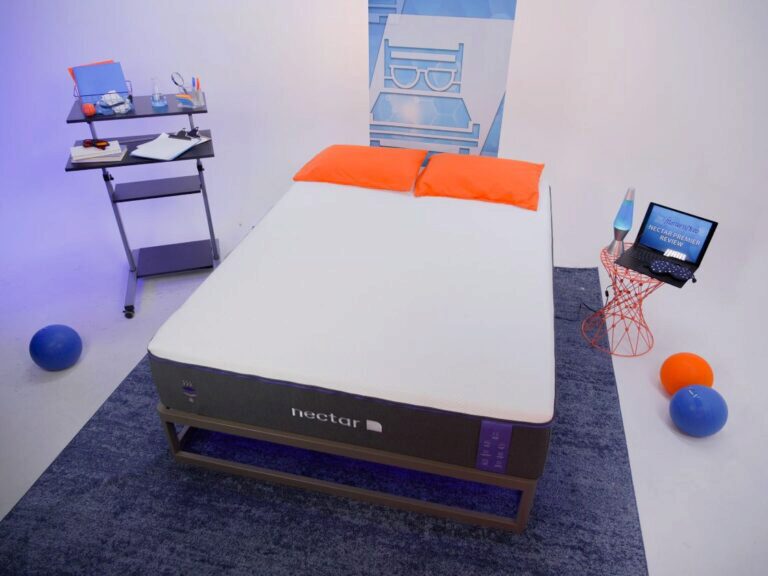
Material
Foam
Trial Period
365 nights
Shipping Method
Free shipping
Firmness
Medium-soft: 5.5/10
Warranty
Lifetime warranty
Price Range
$$$$$
Hip Pain
This bed is perfect for anyone suffering from hip pain.
Back Sleeping
Ideal for lightweight and average weight back sleepers.
Side Sleeping
Ideal for lightweight and average weight side sleepers.
Financing Options
Nectar Premier Mattress

Material
Foam
Warranty
Lifetime warranty
Firmness
Medium-soft: 5.5/10
Shipping Method
Free shipping
Trial Period
365 nights
Price Range
$$$$$
Hip Pain
This bed is perfect for anyone suffering from hip pain.
Back Sleeping
Ideal for lightweight and average weight back sleepers.
Side Sleeping
Ideal for lightweight and average weight side sleepers.
Financing Options

Nectar Premier Mattress
Material
Foam
Firmness
Medium-soft: 5.5/10
Trial Period
365 nights
Warranty
Lifetime warranty
Shipping Method
Free shipping
Price Range
$$$$$
Hip Pain
This bed is perfect for anyone suffering from hip pain.
Back Sleeping
Ideal for lightweight and average weight back sleepers.
Side Sleeping
Ideal for lightweight and average weight side sleepers.
Financing Options
Read our Nectar Premier mattress review for more information.
The Nectar Premier Copper is a luxury foam mattress infused with special cooling materials such as gel, copper, and Phase Change Material. This mattress is a great option for back sleepers who love all-foam beds.
We recommend this mattress for the following sleeper types: Financing options are available for this mattress. The Nectar Premier Copper is a luxury foam mattress infused with special cooling materials such as gel, copper, and Phase Change Material. This mattress is a great option for back sleepers who love all-foam beds.
We recommend this mattress for the following sleeper types: Financing options are available for this mattress. The Nectar Premier Copper is a luxury foam mattress infused with special cooling materials such as gel, copper, and Phase Change Material. This mattress is a great option for back sleepers who love all-foam beds.
We recommend this mattress for the following sleeper types: Financing options are available for this mattress.Nectar Premier Copper Mattress
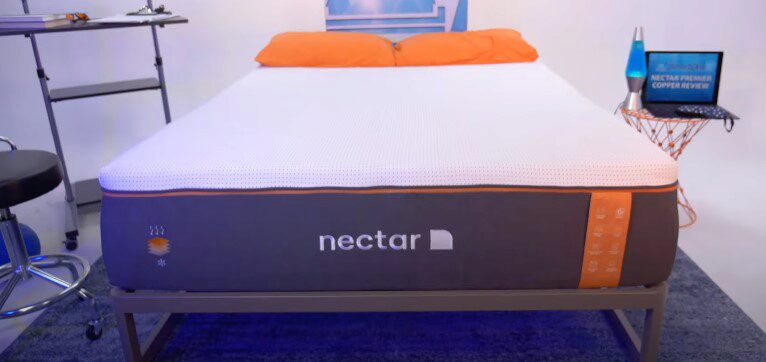
Material
Foam
Trial Period
365 nights
Shipping Method
Free shipping
Firmness
Medium-soft: 5/10
Warranty
Lifetime warranty
Price Range
$$$$$
Hot Sleepers
If you often overheat while you sleep, this mattress should help you stay cool.
Hip Pain
This bed is perfect for anyone suffering from hip pain.
Back Sleeping
Ideal for lightweight and average weight back sleepers.
Side Sleeping
Ideal for lightweight and average weight side sleepers.
Financing Options
Nectar Premier Copper Mattress

Material
Foam
Warranty
Lifetime warranty
Firmness
Medium-soft: 5/10
Shipping Method
Free shipping
Trial Period
365 nights
Price Range
$$$$$
Hot Sleepers
If you often overheat while you sleep, this mattress should help you stay cool.
Hip Pain
This bed is perfect for anyone suffering from hip pain.
Back Sleeping
Ideal for lightweight and average weight back sleepers.
Side Sleeping
Ideal for lightweight and average weight side sleepers.
Financing Options

Nectar Premier Copper Mattress
Material
Foam
Firmness
Medium-soft: 5/10
Trial Period
365 nights
Warranty
Lifetime warranty
Shipping Method
Free shipping
Price Range
$$$$$
Hot Sleepers
If you often overheat while you sleep, this mattress should help you stay cool.
Hip Pain
This bed is perfect for anyone suffering from hip pain.
Back Sleeping
Ideal for lightweight and average weight back sleepers.
Side Sleeping
Ideal for lightweight and average weight side sleepers.
Financing Options
Read our Nectar Premier Copper mattress review for more information.
The TEMPUR-ProAdapt lives up to its name: It adapts to every sleeping position (side, back and stomach sleepers), offers three firmness levels (soft, medium and firm) and works for all weight groups (light, average-weight and heavyweight sleepers).
We recommend this mattress for the following sleeper types: Financing options are available for this mattress. The TEMPUR-ProAdapt lives up to its name: It adapts to every sleeping position (side, back and stomach sleepers), offers three firmness levels (soft, medium and firm) and works for all weight groups (light, average-weight and heavyweight sleepers).
We recommend this mattress for the following sleeper types: Financing options are available for this mattress. The TEMPUR-ProAdapt lives up to its name: It adapts to every sleeping position (side, back and stomach sleepers), offers three firmness levels (soft, medium and firm) and works for all weight groups (light, average-weight and heavyweight sleepers).
We recommend this mattress for the following sleeper types: Financing options are available for this mattress.TEMPUR-ProAdapt Mattress
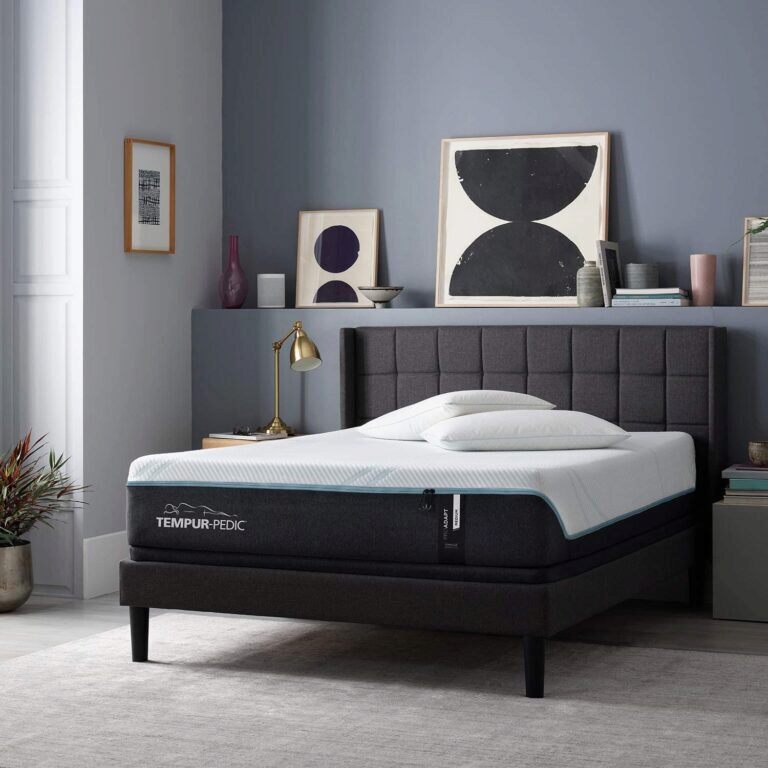
Material
Foam
Trial Period
90 nights
Shipping Method
Free white glove delivery
Firmness
Multiple firmness options
Warranty
10-year limited warranty
Price Range
$$$$$
Seniors
This bed is perfect for senior sleepers.
Joint Pain
This bed is perfect for anyone suffering from joint pain.
Hip Pain
This bed is perfect for anyone suffering from hip pain.
Back Pain
This bed is perfect for anyone suffering from back pain.
Financing Options
TEMPUR-ProAdapt Mattress

Material
Foam
Warranty
10-year limited warranty
Firmness
Multiple firmness options
Shipping Method
Free white glove delivery
Trial Period
90 nights
Price Range
$$$$$
Seniors
This bed is perfect for senior sleepers.
Joint Pain
This bed is perfect for anyone suffering from joint pain.
Hip Pain
This bed is perfect for anyone suffering from hip pain.
Back Pain
This bed is perfect for anyone suffering from back pain.
Financing Options

TEMPUR-ProAdapt Mattress
Material
Foam
Firmness
Multiple firmness options
Trial Period
90 nights
Warranty
10-year limited warranty
Shipping Method
Free white glove delivery
Price Range
$$$$$
Seniors
This bed is perfect for senior sleepers.
Joint Pain
This bed is perfect for anyone suffering from joint pain.
Hip Pain
This bed is perfect for anyone suffering from hip pain.
Back Pain
This bed is perfect for anyone suffering from back pain.
Financing Options
Read our Tempur-Pedic Adapt mattress reviews for more information.
The Tempur-Cloud is a more affordable Tempur-Pedic mattress. The foams are slow moving, so side sleepers will sink into the memory foam layers. It will easily absorb motion so couples sleep undisturbed.
We recommend this mattress for the following sleeper types: Financing options are available for this mattress. The Tempur-Cloud is a more affordable Tempur-Pedic mattress. The foams are slow moving, so side sleepers will sink into the memory foam layers. It will easily absorb motion so couples sleep undisturbed.
We recommend this mattress for the following sleeper types: Financing options are available for this mattress. The Tempur-Cloud is a more affordable Tempur-Pedic mattress. The foams are slow moving, so side sleepers will sink into the memory foam layers. It will easily absorb motion so couples sleep undisturbed.
We recommend this mattress for the following sleeper types: Financing options are available for this mattress.TEMPUR-Cloud Mattress
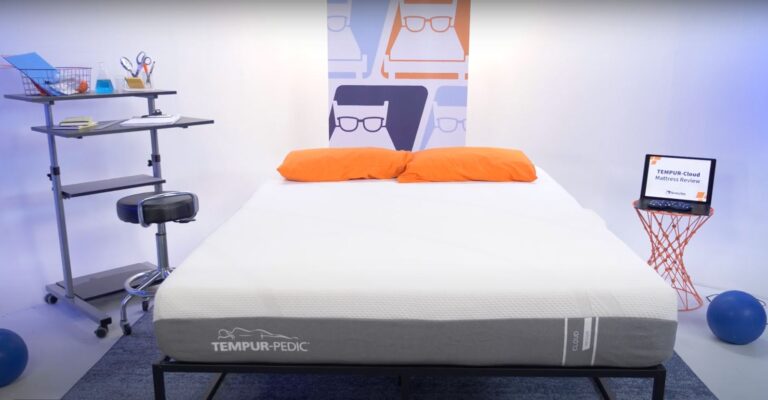
Material
Foam
Trial Period
90 nights
Shipping Method
Free shipping
Firmness
Medium-firm: 7/10
Warranty
10-year warranty
Price Range
$$$$$
Couples
This bed has great motion isolation so you will not feel your partner tossing and turning at night.
Seniors
This bed is perfect for senior sleepers.
Back Pain
This bed is perfect for anyone suffering from back pain.
Back Sleeping
Ideal for lightweight and average weight back sleepers.
Side Sleeping
Ideal for average weight side sleepers.
Financing Options
TEMPUR-Cloud Mattress

Material
Foam
Warranty
10-year warranty
Firmness
Medium-firm: 7/10
Shipping Method
Free shipping
Trial Period
90 nights
Price Range
$$$$$
Couples
This bed has great motion isolation so you will not feel your partner tossing and turning at night.
Seniors
This bed is perfect for senior sleepers.
Back Pain
This bed is perfect for anyone suffering from back pain.
Back Sleeping
Ideal for lightweight and average weight back sleepers.
Side Sleeping
Ideal for average weight side sleepers.
Financing Options

TEMPUR-Cloud Mattress
Material
Foam
Firmness
Medium-firm: 7/10
Trial Period
90 nights
Warranty
10-year warranty
Shipping Method
Free shipping
Price Range
$$$$$
Couples
This bed has great motion isolation so you will not feel your partner tossing and turning at night.
Seniors
This bed is perfect for senior sleepers.
Back Pain
This bed is perfect for anyone suffering from back pain.
Back Sleeping
Ideal for lightweight and average weight back sleepers.
Side Sleeping
Ideal for average weight side sleepers.
Financing Options
Check out our TEMPUR-Cloud mattress review to learn more.
The Nectar and TEMPUR-Adapt mattresses are both bed-in-a-box memory foam mattresses that are widely available online and in brick-and-mortar mattress stores. Price might be a large factor in your decision between the two. Value shoppers who want to spend around $1,000 should opt for the Nectar, and luxury mattress shoppers who are curious about the Tempur-Pedic brand but don’t want the most expensive Tempur-Pedic mattress should enjoy the TEMPUR-Adapt. Both work well for couples because they reduce both motion isolation and noise.
Both also work well for average-weight sleepers in most sleeping positions. If you’re a strict side sleeper, the Nectar’s slightly softer feel may suit you better. Back sleepers can do well on either mattress, and strict stomach sleepers should opt for a firmer mattress. If you sleep particularly hot, we recommend the hybrid version of the TEMPUR-Adapt, which has a cool-to-the-touch cover and coil support core to enhance airflow, keeping you cool.
No. You don’t need to flip your Tempur-Pedic bed to improve its durability or to change the firmness level of your mattress. The Tempur-Adapt, along with other Tempur-Pedic beds, are durable and designed to return to their original shape each year, without needing to be flipped.
As with almost all memory foam mattresses from online mattress companies, customers will experience some off-gassing when they first unbox a new Nectar Mattress. The smell is normal and expected: it comes from the materials used to create the foams. It should start to go away within two to three days of airing out. See More FAQs at nectarsleep.com.
Yes! As long as you are the original owner, Nectar will replace your mattress if something goes wrong. Nectar claims that, if you own a Nectar Sleep Mattress, that is the only mattress you should ever own.